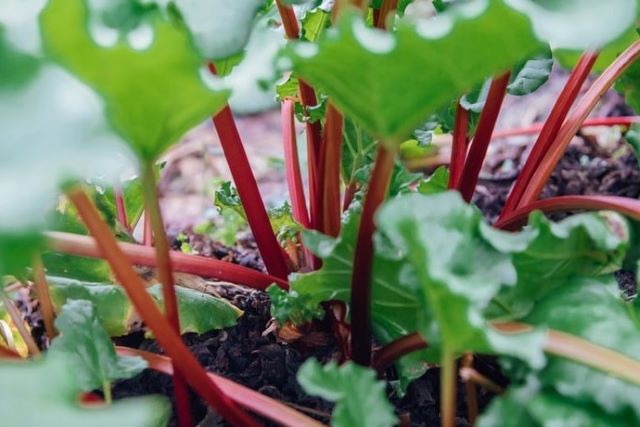Rhubarb is known for its delicious stalks, while the leaves of the plant are inedible. So of course, you’re going to what thick, juicy rhubarb stalks. But what do you do when your rhubarb stalks are thin?
Luckily, this issue can be fixed. In this post, I’ll look at why your rhubarb might be thin, and how you can fix that to continue harvesting an abundant crop.
The main reasons why rhubarb is thin are because the plants are too young, there’s not enough growing space, insufficient soil nutrients, the wrong rhubarb variety, or inadequate care for the rhubarb plant.

Table of Contents
Rhubarb is Thin Because Plants Are Too Young
One of the most common reasons for rhubarb being thin is that the plant is simply too young. A common mistake for gardeners is harvesting rhubarb before it’s ready.
Typically, rhubarb stalks tend to be quite thin in their first two years or growing seasons. Because of this, it’s best to avoid harvesting in this time, to give them adequate time to get established. Once they’re established, they’ll start to grow thicker stalks that would be good for harvest.
So try to wait to harvest your rhubarb until it’s been established, two years after planting. The next growing season, the stalks will be much bigger, and more what you’re looking for. Then, you can keep harvesting them until the plant has grown so much it needs to be split.
Not Enough Growing Space Causes Thin Rhubarb Stalks
Another common reason for thin rhubarb stalks is when rhubarb doesn’t have enough space. This can be for two reasons: crowding by other plants, or crowding themselves.
If there are a lot of other plants in the area around your rhubarb, they might fight for root space, or the leaves could block out the sun. Both of these will cause your rhubarb plants to have thinner stalks. So try to make sure they’re not crowded and have plenty of space to grow. Generally, rhubarb should be planted 2-4 feet apart, so try to keep other plants out of this range as well.
Rhubarb can also crowd itself. It reproduces by spreading rhizomes beneath the soil, and as it grows older, it will produce more and more offshoots. Eventually, if a plant has too many offshoots, there will be too many plants competing for space, nutrients, and sunlight. This then makes your rhubarb stalks thin.
So, if you have thin rhubarb stalks and a lot of offshoots on a mature plant, it’s time to split that plant. You can do this by digging it up and carefully splitting it into sections with a clean knife or spade. Each section should have at least 2-3 offshoots and a good portion of the roots.
After splitting your rhubarb, you can simply replant each section, at the same depth they were before. Make sure you give them adequate space from each other, as each section will continue to reproduce and grow on its own. Then, you’ll have thicker stalks, and even more of them than you did before! It’s because of this that rhubarb can be continually grown for a long time without having to buy more plants, because it will reproduce on its own.
Insufficient Soil Nutrients Cause Rhubarb to be Thin
Rhubarb plants need a lot of nutrients to grow big stalks. Having an imbalance of nutrients, or simply not enough, will cause the stalks to grow thinner, and can cause other issues with the plant.
If your rhubarb stalks are thin and you can rule out the other causes on this list, you probably have a nutrient deficiency. The most important nutrients for rhubarb are nitrogen and phosphorous, so there’s a good chance your soil is low on one of these.
You can add organic compost or manure to your soil, but to really get your rhubarb stalks to thicken up, you might want to use an organic fertilizer that will give you a more reliable balance of nutrients. An organic edible plant fertilizer like this one will work well. This contains beneficial nutrients to feed the soil and help your rhubarb plants thrive.
The Wrong Variety of Rhubarb Causes Thin Stalks
While rhubarb is often prized for its thick stalks, there are some varieties that have thin stalks, regardless of how you care for them. If you have one of these varieties, you’re not going to get very thick stalks.
Some common thinner varieties of rhubarb are Canada Red, which has thin and tasty stalks, or Victoria, which has more medium-sized dark stalks.
If you want thicker rhubarb stalks, you should start by choosing a variety that will give you thicker stalks! Cherry Red and Mammoth Red are two common varieties that gardeners love, with juicy, succulent stalks. Riverside Giant and Sunrise both have pretty thick stalks. Or you can always try the German Wine variety, which many say is great for making wine.
Inadequate Care Causes Thin Rhubarb Stalks
Lastly, simply not caring for rhubarb in the right way can cause thin stalks. This can also cause other problems with the plant, so it’s important to take care of rhubarb as best as possible.
Rhubarb soil should be moist, but not soggy. You don’t want to overwater rhubarb. Additionally, the soil should be well-draining. Rhubarbs like partial shade, and can struggle in temperatures above 75 °F (24 °C). Lastly, be sure to keep rhubarb free from weeds, pests, and disease whenever possible.
Of course, it’s also possible that a combination of things can be causing thin stalks in your rhubarb. If you’re having this issue, consider all of the possible causes above. If any of them seems likely, treat for it. It won’t hurt to try to treat multiple issues at once, and most likely you’ll end up with healthy and happy rhubarb as a result.
Further reading:
